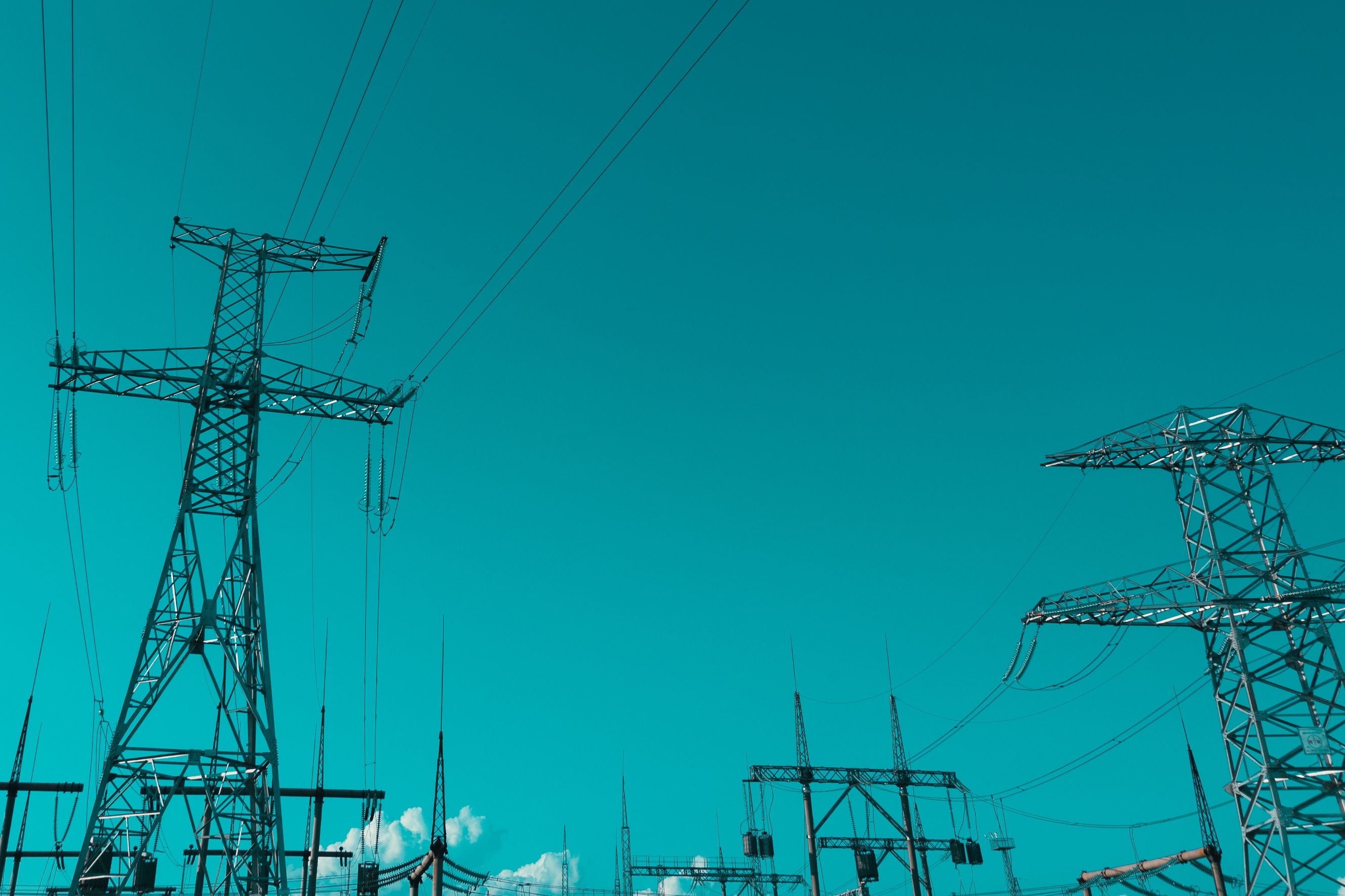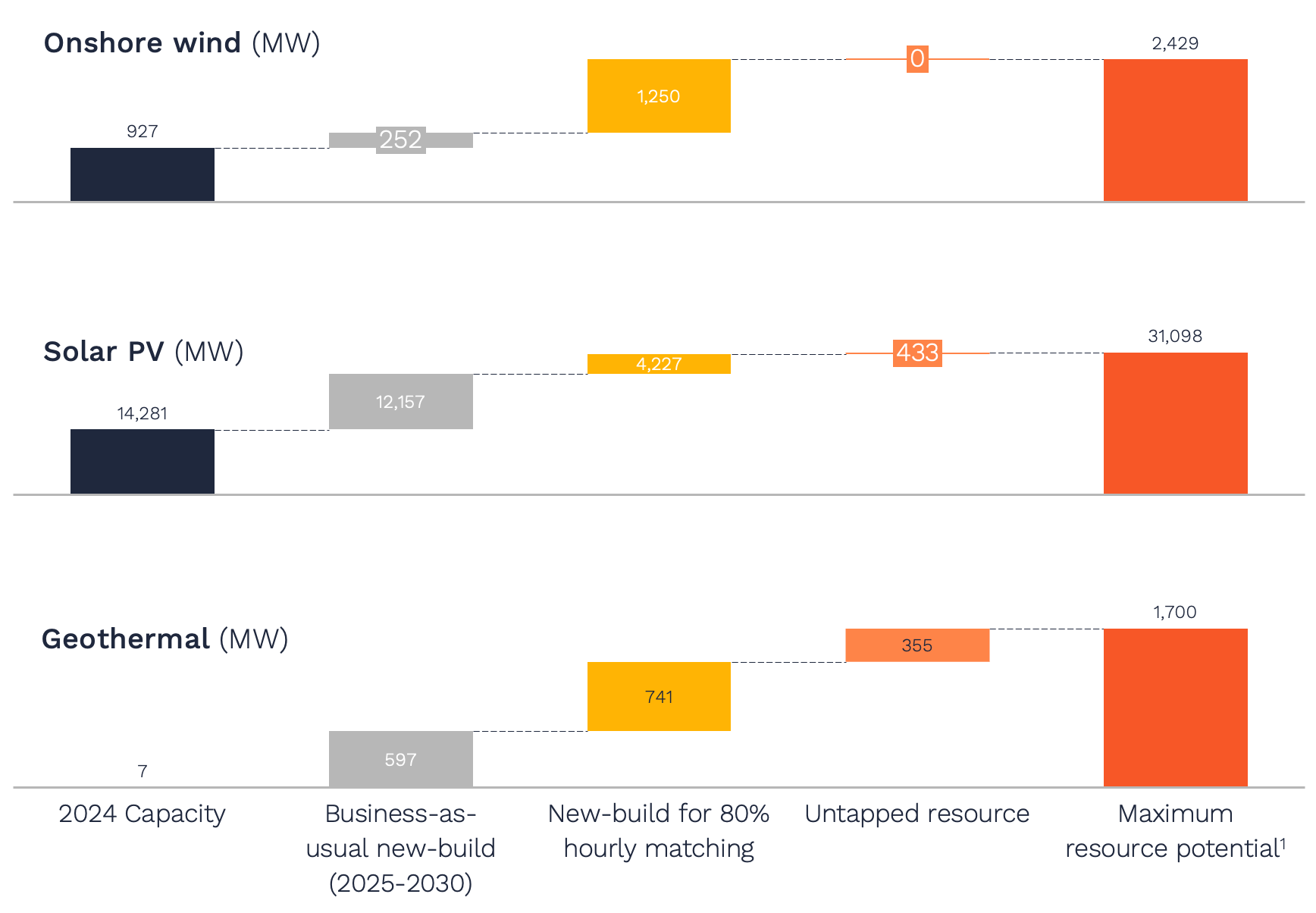Analysis
October 10, 2025
Modelling 24/7 Carbon Free Electricity in Taiwan
Hourly matching commercial and industrial demand with clean power in Taiwan could save nearly US$1 billion and 5 MtCO₂e annually, all at a lower unit cost than recent tariffs, according to new TransitionZero modelling.

Summary
In December 2024, Taiwan raised its 2030 emissions target from 24% ±1% to 28% ±2% below 2005 levels. As Asia’s ninth-largest economy and the world’s semiconductor hub, Taiwan’s energy choices have outsized global implications, influencing companies that depend on its high-value exports. This renewed pledge is therefore a timely move amid the challenges of transitioning to a grid powered by low-cost, variable renewables. Our analysis highlights the strong benefits for commercial and industrial consumers in shifting toward hourly matched 24/7 carbon free energy (CFE).
We developed a representative model of Taiwan’s 2030 business-as-usual (BAU) power system using the open-source PyPSA framework, simulating the grid as a single node with hourly resolution. The model explores various clean electricity policies and technology configurations layered onto the reference scenario to assess their system-wide cost and emissions impacts. It assumes 5% of total grid demand comes from C&I consumers participating in clean electricity matching, reflecting the broader shift toward corporate decarbonisation.
Results show that if 5% of Taiwan’s grid demand achieved 80% hourly CFE matching, the system could save nearly US$1 billion and 5 MtCO₂e each year at a lower unit cost than recent tariffs. Reaching this level of hourly matching does not require costly offshore wind or batteries if cheaper onshore wind, solar, and geothermal are fully utilised, while introducing new dispatchable technologies could make 100% CFE achievable at barely any additional cost
Taiwan's energy ambitions
In December 2024, the government raised its 2030 emissions reduction target from 24% ±1% to 28% ±2% below 2005 levels, signalling renewed climate ambitions even as doubts grow over its renewable energy rollout. The government had already pushed back its original goal of sourcing 20% of power from renewables by 2025 to late 2026, although meeting this new deadline remains uncertain. As the world’s semiconductor hub and Asia’s ninth-largest economy, Taiwan’s energy decisions carry global weight, shaping how technology leaders that depend on its high-value exports decarbonise their supply chains.
The stronger climate pledge is a timely step as the country faces both opportunities and obstacles in shifting to a grid powered by low-cost, variable renewable energy.
At the centre of this transition is Taiwan’s ability to deliver round-the-clock carbon-free electricity (24/7 CFE) at scale. As policymakers bring more variable renewable energy onto the grid and companies adjust to upcoming Greenhouse Gas Protocol accounting changes, two big questions arise:
What is 24/7 CFE, and what would it take to make it real for Taiwan?
What is 24/7 carbon free energy?
Wind and solar, the cheapest sources of clean energy today, are variable by nature. Electricity consumers seeking to decarbonise their electricity use with variable renewable energy face a persistent mismatch between when clean power is generated and when it is needed. Currently, the dominant approach to procuring and accounting for emissions reductions is based on ‘annual matching’. This involves corporations matching their consumption of electricity with the supply of clean electricity over a year, which results in cycles of surplus and deficit, as fossil-based generators must be relied upon to pick up the slack, thereby introducing emissions. If rather than matching electricity use with electricity from carbon free sources on an annual basis, we instead move to hourly matching, we can move closer to a decarbonised grid.
This approach is a central focus of the Greenhouse Gas Protocol (GHGP), which governs how companies account for emissions from purchased electricity, and is in the process of a multi-year revision of its standards. While hourly emissions accounting is emerging as the preferred accounting method, the GHGP does not set targets or grade performance.
How well a consumer is meeting their 24/7 CFE goal can be summarised by their CFE score for any given hour. This is the percentage of their generation that comes from carbon free sources, and considers both the generation from CFE power purchase agreements (PPAs), and electricity purchased from the grid. To calculate the scores, we follow the methodology set out by Google.
What are the cost, investment and emission implications of a 24/7 CFE for Taiwan?
We built a detailed, open-source model of Taiwan’s electricity grid to explore the implications of 24/7 CFE for corporate buyers and grid planners. Specifically:
- What does hourly matched procurement mean for corporate buyers from a cost and supply perspective?
- What are the costs and benefits of this change in procurement strategy for the grid, i.e. does it increase or decrease costs, investments and emissions?
Model setup
To answer these questions, we developed a representative model of Taiwan’s 2030 business-as-usual (BAU) power system using the open-source Python for Power System Analysis (PyPSA) package. The model is a copper-plated grid dispatch or production cost model with 8,760-hour temporal resolution, modelling Taiwan as a single grid node.
Building on the BAU model, we explored different clean electricity policies with different generation technology configurations, or palettes, to understand the cost, investment, and emissions implications.
In our model, 5% of Taiwan’s total grid demand in 2030 is attributed to C&I consumers participating in clean electricity matching. This share is intended to represent broader trends in C&I demand moving towards decarbonisation.
This CFE demand is modelled under two schemes: annual matching and hourly matching, with the latter tested at CFE levels ranging from 70% to 100% of hours in a year. C&I consumers meet this demand through PPAs with new clean generators, which the model builds and optimises. When renewable generation on the grid is high, certain hours of C&I demand can also be covered by purchasing clean electricity directly from the grid.
For more information on the methodology, please refer to our modelling methodology documentation.
What we found
If 5% of Taiwan’s grid electricity demand adopted CFE 80 hourly matching, the system could save nearly US$1 billion and 5 MtCO₂e annually, all at a lower unit cost than current tariffs
Our study reveals that adopting the 80% CFE scenario delivers both cost savings and significant emissions reductions.
If corporations amounting to 5% of Taiwan’s grid electricity demand followed this pathway, it would require around NT$38 billion (around US$1.3 billion) in annualised capital expenditures for asset development. However, the corresponding renewable build-out would save roughly NT$25 billion (around US$1 billion) in fossil fuel consumption by grid generators annually, and avoid nearly 5 MtCO2e emissions to the Taiwanese power system per year. It would also eliminate almost 75% of corporates’ emissions intensity from clean electricity consumption as opposed to relying on grid supply.
According to the modelling, adopting 80% hourly matching also makes economic sense on a per KWh basis. The unit costs for securing PPAs are around NT$2.7/kWh (around US$92/MWh), which is 7% cheaper in real terms than the lowest observed average annual electricity tariff of NT$2.9/kWh (around US$99/MWh) recorded from 2019 to 2024. Moreover, as these historical tariffs are heavily subsidised, PPA-based CFE becomes even more competitive when compared with the true cost of generation.
Expensive offshore wind and batteries are not required for CFE 80 if cheaper renewable sources can be fully exploited
Achieving CFE 80 with hourly matching is within reach, but it requires C&I consumers to maximise land-limited renewables while also drawing on the broader potential of geothermal.
At this level, storage is not yet needed — only appearing at CFE 90 onwards but growing steeply towards full decarbonisation— and costly offshore wind does not appear in the system. Instead, the focus is on cheaper sources with about 6.2 GW of additional generation and storage.
However, this pathway relies on pushing existing renewable resources close to their practical limits. Given the current government ambition, this implies accelerating solar deployment by 5 years, utilising all remaining onshore wind secondary sites, and meeting the government’s 2032 geothermal target in full.

Renewable build constraints
By bringing in novel dispatchable technologies, even CFE 100 is achievable
When moving from 80% to 100% CFE, including new technologies can significantly reduce the required renewable and storage buildouts. Adding liquid air energy storage (LAES) and gas turbines equipped with carbon capture and storage (CCS) eliminates the need for costly offshore wind and significantly reduces reliance on hybrid renewable-battery systems. Gas CCS reduces the need to overbuild variable renewables and time-shifting batteries to cover low renewable-output periods, easing the pressure on limited renewable resources. However, this is only the case if as much as 70% of combustion CO2 is sequestered in Taiwan. Either a lower sequestration performance or the need to store CO2 abroad reduces the attractiveness of CCS, lowering its buildout and increasing that of liquid air energy storage instead.
As a result, including new technologies largely offsets the increase in capital investment requirements. System costs escalate much less at higher CFE scores when flexible technologies are available. At CFE 100, system-wide capital expenditures fall by 61% with high-performing gas CCS (from NT$136.6 billion to NT$53.1 billion), and by 55% with low-performing gas CCS (from NT$136.6 billion to NT$60.9 billion) compared to using conventional renewables and batteries only. This reduction in capacity is driven by two key factors: cost and dispatchability. Offshore wind, which is both seasonal and expensive, is reduced first, followed by solar. Geothermal and onshore wind are fully utilised at their limits, while dispatchable technologies fill the remaining gap.
Click the link below to read the full report.
(1) Maximum resource potential is calculated based on government’s target for 2035 – but assumed to be available in this study already by 2030.
(2) We assume a final sequestration rate of 70% for high-performing CCS and 50% for low-performing CCS.



